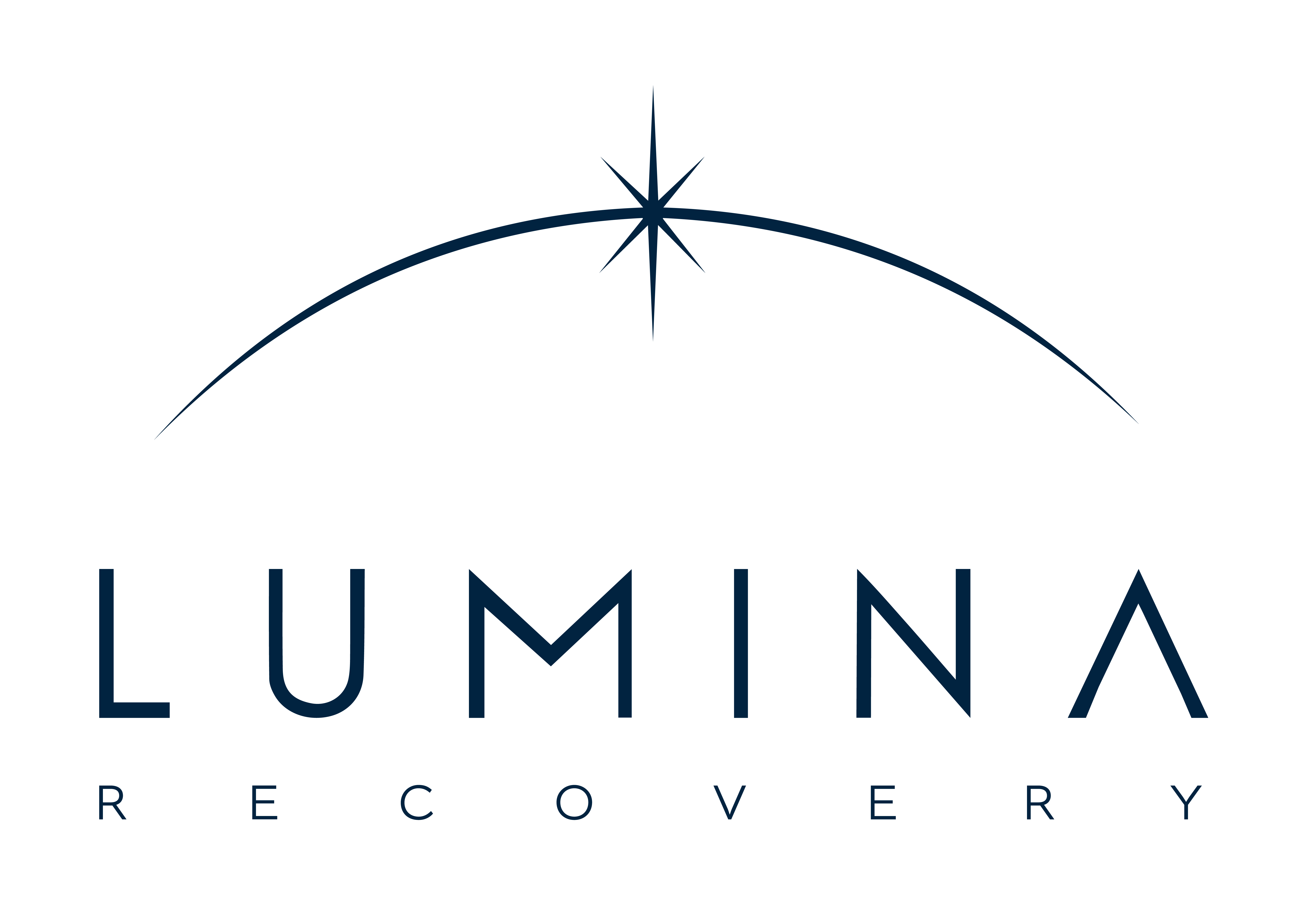
Our Addiction Resources
Navigating the world of addiction and recovery can be overwhelming. We’re here to provide clear, compassionate education and guidance. From practical advice for maintaining sobriety to informational guidance on the long-term effects of substance abuse, our content is a beacon of hope and understanding.
Our Team is Ready are ready to take your call
Call us Today!
or we can call you. Fill out form below
Our Blog

5 Benefits of Yoga for Addiction Recovery
If you or a loved one is navigating the challenging journey of addiction recovery, you might be searching for holistic and supportive ways to aid the recovery process.
Yoga, known for its physical, mental, and spiritual benefits, has emerged as a powerful source of support in addiction recovery. Incorporating yoga into your addiction treatment plan can offer profound benefits, enhancing well-being on all levels.
1. Enhances Physical Health
Yoga serves as a powerful form of physical exercise. It can help detoxify your body, strengthen your immune system, and enhance heart health by decreasing heart rate and blood pressure.
Such benefits are vital for anyone recovering from addiction. The process of detoxification is particularly important, as it helps in clearing substances from your body, paving the way for a healthier lifestyle.
Physical strength and flexibility are core components of yoga. These aspects symbolize taking back control over your body. When you feel strong and flexible, you’re reminded of your ability to overcome challenges, including those posed by addiction.
2. Reduces Stress and Anxiety
Yoga is well-known for its ability to calm the mind. Through specific breathing techniques and meditation, it can reduce stress and anxiety. For people in recovery, managing stress is crucial. Stress and anxiety are common triggers for relapse in substance abuse. Learning to calm your mind through different forms of yoga can provide a strong defense against these triggers.
The practice of yoga encourages a deep connection between your mind and body. This connection is essential in recognizing and dealing with cravings and emotional triggers related to addiction. By becoming more aware of these feelings, you can manage them more effectively, reducing the risk of relapse.
3. Promotes Emotional Healing
Yoga offers a safe environment for emotional release and healing. Yoga therapy allows individuals to try to face and process underlying emotional issues contributing to addiction. This emotional processing can lead to profound healing, addressing the root causes of addiction.
Yoga may also boost self-esteem and foster self-compassion. For those in recovery, learning to forgive oneself and move forward with compassion is essential. Yoga supports this journey, encouraging individuals to view themselves with kindness and understanding.
4. Supports Spiritual Growth
For many, yoga can be a spiritual journey that offers a sense of connection to a greater purpose or existence. This spiritual exploration can provide new perspectives on life, essential for those recovering from addiction. It can inspire a sense of hope and purpose, which are crucial for sustaining recovery.
Mindfulness and living in the present are key teachings of yoga. These practices help individuals focus on their recovery journey, appreciating each moment and the progress they make. This mindfulness can be particularly empowering, keeping individuals anchored in their journey towards sobriety.
5. Fosters Community and Support
Participating in yoga classes enables the exchange of personal experiences and mutual support, reinforcing the idea that no one is alone in their struggles. The act of coming together, breathing, and moving in unison can be incredibly powerful, fostering a sense of unity and shared purpose.
The community aspect of yoga extends beyond the physical space of a studio. Online forums, virtual classes, and social media groups offer additional avenues for connection, allowing those who may not have access to in-person classes to still benefit from the collective support of the yoga community.
Whether in person or online, the connections made through yoga can provide a lifeline during challenging times, offering encouragement, understanding, and a reminder of the common goal of healing and growth.

Incorporating Yoga Into Recovery
Recovery is a deeply unique journey, and finding evidence-based treatment tools to support your path is crucial. Yoga is one such tool that may offer immense benefits during your treatment program and beyond. Here’s how you can start integrating yoga into your recovery process, step by step:
Start with gentle yoga. If you’re new to yoga or still dealing with physical challenges from addiction, start slow. Gentle yoga styles, like Hatha or Restorative yoga, focus on slow movements and deep relaxation. They’re perfect for beginners and help introduce the body to yoga’s healing practices without overwhelming it.
Find the right class for you. Look for yoga classes that cater specifically to those in recovery. These classes often provide a supportive environment that understands the unique needs and challenges faced during recovery. Teachers in these classes are usually trained to offer modifications and support for all levels, ensuring a safe and inclusive experience.
Create a routine. Consistency is key in recovery and yoga practice. Try to set aside regular times each week for yoga, even if it’s just a few minutes a day. This routine can help establish yoga as a stable, comforting presence in your life, offering regular moments of calm and reflection.
Listen to your body. One of the core teachings of yoga is to be attuned to your body’s needs and limits. As you practice, pay attention to how different poses and exercises feel. If something hurts or feels wrong, adjust or skip it. Yoga is about nurturing yourself, not pushing through pain.
Embrace the community. Yoga can be more than just a personal practice—it’s also about community. If you’re comfortable, engage with your classmates before or after sessions. Sharing your experiences and listening to others can enhance the sense of support and understanding, reinforcing that you’re not alone on this journey.
Explore online resources. If attending classes in person is challenging, plenty of online resources can help you practice yoga at home. Look for online classes or YouTube tutorials designed for beginners or specifically for recovery. This flexibility allows you to incorporate yoga into your life in a way that suits your schedule and comfort level.
Be patient and persistent. Remember, the benefits of yoga unfold over time. Approach your practice with patience and persistence, understanding that every day might feel different. Celebrate your progress, no matter how small it seems. Each step forward is a victory in your recovery journey.
Learn More About the Benefits of Yoga for Addiction Treatment With Lumina Recovery
Yoga offers a holistic approach to addiction recovery, addressing physical health, reducing stress, promoting emotional healing, supporting spiritual growth, and fostering a supportive community.
Lumina Recovery provides residential inpatient services where yoga practice is encouraged. By incorporating yoga into your recovery process, you can harness these benefits to support your journey towards health and sobriety.
Our team of professionals is ready to hear from you, so don’t hesitate to reach out today.

6 Types of Yoga for Your Addiction Recovery Journey
Finding holistic ways to heal the mind, body, and spirit during addiction recovery is crucial. Yoga, an ancient practice with roots stretching back thousands of years, offers a path toward healing that encompasses physical, mental, and emotional well-being.
Practicing yoga encourages self-reflection, inner peace, and physical resilience, making it a valuable tool for those battling addiction. Various types of yoga can support individuals in their recovery journey, offering a gentle yet powerful way to navigate the challenges of substance use disorders and foster a sense of balance and well-being.
The Principles of Yoga for Addiction Recovery
The principles and foundation of yoga for addiction recovery are rooted in the practice’s holistic approach to healing and transformation. Yoga offers a path to self-discovery, balance, and renewal, addressing the mental, physical, and spiritual aspects of the individual.
Through a combination of physical postures (asanas), breath control (pranayama), and meditation (dhyana), yoga cultivates a sense of inner peace, resilience, and strength. It encourages the release of physical stress and anxiety by clearing mental clutter and creating space for positive change and growth.
The practice teaches mindfulness, helping individuals become more aware of their thoughts, emotions, and behaviors, and fostering a deeper connection with themselves. This self-awareness is crucial for those in recovery, as it enables them to help identify triggers, manage stress, and develop healthier coping mechanisms.
Yoga’s emphasis on discipline, patience, and self-compassion provides a supportive framework for overcoming addiction, encouraging individuals to embrace their journey with kindness and perseverance. Through its integrative approach, the benefits of yoga as part of addiction treatment and recovery offer a powerful means of achieving lasting change and well-being.
The Different Forms of Yoga
While there are many forms of yoga, we’re going to concentrate on six common types you might come across if you are new to the practice of yoga.
1. Hatha Yoga
Hatha yoga is often the entry point for beginners to the world of yoga, making it ideal for those seeking a gentle introduction or beginning their journey of recovery. Characterized by its slow pace, this style focuses on the fundamentals of yoga postures (asanas) and breath control (pranayama).
Practitioners are encouraged to hold each pose for several breaths, fostering an environment of mindfulness and physical awareness. The deliberate pace of Hatha yoga allows for a deeper exploration of each posture, ensuring proper alignment and technique. This practice serves as a foundation upon which individuals can build their yoga practice, emphasizing the importance of breath in connecting the body and mind. This can help reduce stress by regulating the central nervous system.
2. Vinyasa Yoga
Vinyasa yoga is known for its fluid, movement-intensive approach. Unlike the static nature of Hatha yoga, Vinyasa links breath to movement, creating a flowing sequence of poses that seamlessly transition from one to the next.
This dynamic form of yoga is like a dance, with each movement guided by inhales and exhales. The variability of sequences in Vinyasa yoga keeps the practice engaging and allows for a personalized approach, with instructors tailoring sequences to suit the class’s energy and mood.
The focus on continuous movement not only enhances physical strength and flexibility but also encourages mental focus and discipline, making it a stimulating and enriching practice for both body and mind.
3. Yin Yoga
Yin yoga stands in contrast to more dynamic styles like Vinyasa by emphasizing stillness and the passive holding of postures for extended periods, typically three to five minutes each. This approach targets the body’s deeper connective tissues, like fascia, ligaments, and joints, promoting increased flexibility and the release of tension.
Yin yoga’s meditative aspect is pronounced, as the extended hold times provide ample space for inner reflection and mindfulness. Practitioners are invited to observe and sit with their thoughts and emotions, making Yin an introspective practice that encourages patience and self-acceptance.
This style is particularly suited to those seeking to balance more active forms of exercise or needing a practice that supports mental and emotional equilibrium.
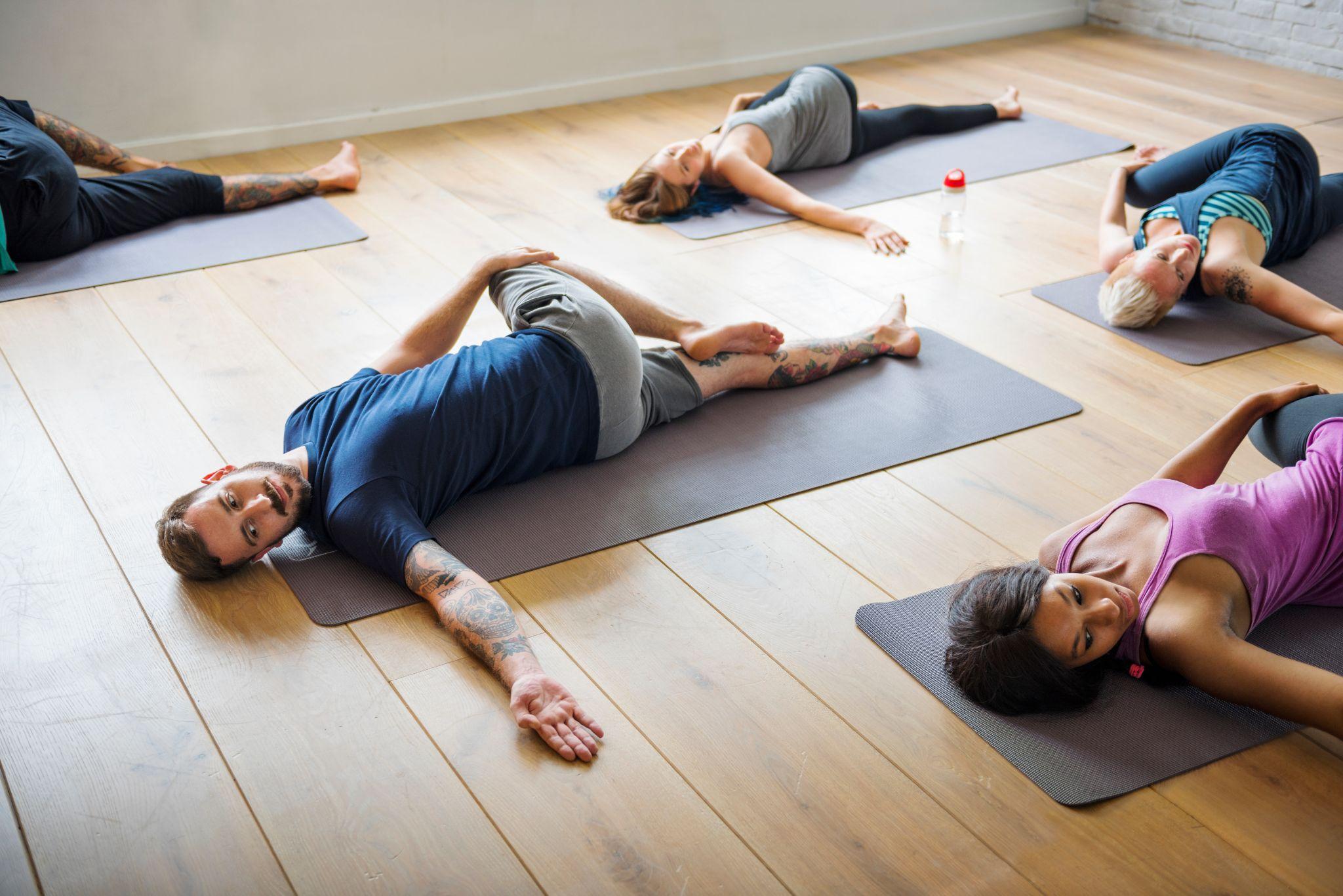
4. Restorative Yoga
Restorative yoga emphasizes relaxation and the gentle release of bodily tension through passive stretching. Unique in its approach, this practice utilizes various props like bolsters, blankets, and blocks to fully support the body in each pose, allowing practitioners to sink into deep relaxation without exerting effort.
The poses are held for extended periods, typically five to twenty minutes, to encourage the body to naturally open and relax. This gentle approach makes Restorative yoga a particularly accessible form of yoga, suitable for individuals of all levels, including those recovering from injuries or dealing with chronic stress.
The primary focus is on comfort and ease, making it a deeply nurturing and calming experience that decreases blood pressure which contrasts with more active yoga styles.
5. Kundalini Yoga
Kundalini yoga, often referred to as the “yoga of awareness,” stands out for its combination of spiritual and physical practices. This style integrates movement, dynamic breathing techniques, meditation, and the chanting of mantras to awaken and raise Kundalini energy from the base of the spine through the seven chakras, and out through the crown of the head.
It is both a spiritual and physical workout, known for its distinctive sequences (kriyas) that are specifically designed to generate energy, increase consciousness, and foster spiritual growth.
Unlike other forms of yoga, Kundalini places a significant emphasis on the internal experience—psychic and spiritual transformation—alongside the physical postures and practices.
6. Ashtanga Yoga
Ashtanga yoga is characterized by its high energy and demanding routine, making it unique among yoga practices for its rigorous sequence of poses. This method involves synchronizing breath with a progressive series of postures, a process that produces intense internal heat and a purifying sweat that helps detoxify muscles and organs.
Ashtanga is divided into six series, each increasing in difficulty, allowing practitioners to progress at their own pace. The practice’s structured nature offers a disciplined approach to personal development and physical fitness, distinguishing it from more fluid styles like Vinyasa.
Ashtanga’s emphasis on repetition and mastery of each pose before moving on to the next contributes to its reputation as both a deeply challenging and immensely rewarding form of yoga.
Explore the Forms of Yoga for Addiction With Lumina Recovery
Yoga, with its diverse practices, offers a holistic approach to drug and alcohol recovery, addressing the physical, mental, and emotional aspects of healing. Whether you are drawn to the gentle flow of a Vinyasa yoga class or the stillness of Yin, incorporating yoga into your recovery journey can provide invaluable support.
Remember, the most important step is to begin, wherever you are, with whatever you have. Lumina Recovery’s treatment programs and therapy services make the path to recovery uniquely yours.
Contact us today to see how we can help you or your loved one.

The Power of Mindfulness in Addiction Recovery
While overcoming addiction, finding effective tools and techniques to pave the path to recovery is crucial. One such powerful approach is mindfulness, a practice rooted in being fully present and engaged in the moment, without judgment.
Lumina Recovery hopes to provide information on the transformative role of mindfulness in addiction recovery, offering insights and guidance for individuals with addiction and their loved ones. By embracing mindfulness, one can unlock a path to healing and hope, fostering resilience and a renewed sense of purpose.
The Essence of Mindfulness in Recovery
Mindfulness is about cultivating a moment-to-moment awareness of our thoughts, feelings, bodily sensations, and surrounding environment with openness, curiosity, and a willingness to be with what is.
This practice, derived from ancient Buddhist traditions, has found a powerful application in modern addiction treatment programs. It’s not merely about meditation but involves a broader application of mindfulness exercises and principles to daily life, encouraging a shift in how individuals relate to their experiences, especially those that might trigger addictive behaviors.
In the context of addiction recovery, mindfulness techniques encourage individuals to observe their cravings, thoughts, and emotions without immediate reaction. It teaches the skill of responding to discomfort or triggers with awareness and choice rather than automatic behavior.
This shift is crucial for breaking the cycle of addiction and using addictive substances. Mindfulness aids in recognizing the impermanent nature of cravings and the possibility of enduring them without succumbing to substance use. This realization fosters a sense of empowerment and control over one’s actions, laying a foundation for lasting recovery.
The Benefits of Mindfulness in Addiction Recovery
Expanding on the benefits, mindfulness offers multifaceted advantages that support individuals throughout their recovery journey.
Deepens understanding of triggers and patterns. Regular practice of mindfulness enhances self-awareness, allowing individuals to identify and understand the triggers and patterns that lead to substance use disorders. This understanding is vital for developing strategies for improving mental health and avoiding or coping with these triggers in a healthy manner.
Increases resilience to stress. By promoting a calm and focused state of mind, mindfulness helps individuals build resilience against stress and negative thoughts, common triggers for relapse. Techniques like mindful breathing, staying grounded, and meditation provide practical tools for managing stress in the moment, reducing the reliance on substances for stress relief.
Enhances emotional intelligence. Mindfulness fosters emotional intelligence by improving the ability to pay attention to and regulate emotions. This emotional awareness can transform the way individuals respond to difficult situations, enhancing long-term sobriety.
Reduces cravings and improves impulse control. Through mindfulness, individuals learn to observe their cravings with detachment, recognizing them as temporary states that do not require action. This observation reduces the intensity and frequency of cravings over time and acts as a coping skill for impulse control, a key factor in preventing relapse.
Supports holistic healing. Beyond addressing addiction itself, mindfulness supports the healing of underlying issues often associated with substance use, such as anxiety, depression, and trauma. By fostering a compassionate and non-judgmental relationship with oneself, mindfulness encourages healing on a deeper emotional and psychological level.
Promotes a positive outlook on recovery. Mindfulness cultivates a sense of gratitude, acceptance, and optimism, which are essential for a positive recovery experience. By focusing on the present and acknowledging small victories along the way, individuals can maintain motivation and a positive outlook throughout their recovery journey.
Incorporating Mindfulness Into Recovery
Incorporating mindfulness into the journey of addiction recovery offers a pathway to deeper healing and sustained sobriety. By learning to be present and engaged with our experiences without judgment, we can navigate the challenges of recovery with greater ease and resilience.
Mindfulness Meditation
Begin by dedicating a few minutes each day to mindfulness meditation. Sit in a comfortable position and focus on your breath, observing each inhalation and exhalation without trying to change it.
This practice can be expanded over time, but the key is consistency. Utilizing apps or guided meditations can provide structure and variety, helping to cultivate a habit that fits seamlessly into your daily routine.
Mindful Observation
Engage deeply with your surroundings through mindful observation. This can be practiced anywhere like at home, in nature, or even in the midst of a busy day.
Focus on the details of what you see, hear, smell, and feel, allowing yourself to be fully absorbed in the moment. This practice helps to anchor you in the present, reducing worries about the past or future.
Body Scan

Incorporate regular body scans into your practice. Do this by lying down or sitting and slowly directing your attention through different parts of your body, starting at your feet and moving up toward your head.
Be aware of any sensations, tension, or discomfort without judgment, simply acknowledging and gently releasing them. This technique fosters a deeper connection with your body, often revealing how stress and emotions manifest physically.
Mindful Journaling
Create a space for reflective practice through mindful journaling. Write about your daily experiences, thoughts, and feelings with an open and accepting mindset.
This practice can illuminate patterns in your thoughts and behaviors, offering insights into how mindfulness impacts your recovery journey. It’s also a powerful tool for processing emotions and cultivating gratitude.
Mindful Eating
Transform meals into an exercise in mindfulness by eating slowly and with full attention to the experience. Notice the textures, flavors, and sensations of your food, and the process of eating itself.
This practice can enhance your enjoyment of food, improve digestion, and help you develop a healthier relationship with eating.
Mindful Walking
Incorporate mindfulness into physical activity through mindful walking. Whether you’re walking in a park, around your neighborhood, or even just a few steps in your living room, focus on the sensation of each step, the rhythm of your breath, and the environment around you. This can be a refreshing break from the day’s routine and a way to connect with the present moment.
Mindful Communication
Practice being fully present during conversations with others. Listen actively, without formulating a response while the other person is speaking. This not only improves relationships but also helps in developing compassion and empathy, crucial qualities in recovery.
Seek Support
Engaging with mindfulness-based support groups or therapy, such as mindfulness-based stress reduction (MBSR) or mindfulness-based cognitive therapy (MBCT), can provide a structured approach to mindfulness practice. These settings offer guidance, support, and community, enhancing your practice through shared experiences and learning.
Get the Support You Need With Lumina Recovery
The power of mindfulness in addiction recovery lies in its ability to transform our relationship with ourselves and our experiences. It offers a path towards understanding, compassion, and resilience, essential qualities for overcoming addiction.
Lumina Recovery provides a stress dual diagnosis program and individual therapy to help you or your loved one take that step toward recovery. By incorporating mindfulness into the recovery process, individuals can discover a more balanced, peaceful, and fulfilling way of living, free from addiction.
If you want to learn more, don’t hesitate to reach out to Lumina Recovery.

8 Benefits of Meditation in Addiction Recovery
Finding peace and strength within oneself is very important on the road to addiction recovery. Meditation has been practiced in many cultures for centuries and can offer support against addiction.
Its benefits are vast and varied, providing not only a path to inner peace but also a foundation for lasting recovery, reducing the risk of relapse.
Different types of meditation have transformative power in addiction recovery, helping both individuals battling addiction and their loved ones.
All the different types of meditation, with their profound impact on the mind and body, can help those struggling with substance use disorders. Let’s explore the benefits of meditation in addiction recovery.
1. Rewires the Brain
Substance abuse alters the brain’s reward system, leading to a compulsive desire for the addictive substance. Mindfulness meditation has been shown to change brain patterns, enhancing areas responsible for self-control, awareness, and decision-making. This “rewiring” effect can help reduce the dependency on substances by fostering a stronger, more resilient mindset.
Regular meditation practice increases the density of the pre-frontal cortex, the part of the brain associated with higher-order brain functions such as awareness, concentration, and decision-making. Strengthening this area supports better control over impulses and cravings.
The amygdala also plays a crucial role in emotional processing and is often hyperactive in individuals with addiction, leading to heightened stress and negative emotions. Meditation helps in modulating the amygdala’s response to stress, reducing the emotional triggers that can lead to substance use.1
2. Enhances Neuroplasticity
Neuroplasticity refers to the brain’s ability to form new neural connections throughout life. Meditation not only promotes neuroplasticity but also aids in the development of healthier coping mechanisms. By practicing meditation, individuals can create new, positive patterns of thought and behavior that support sobriety.
Through mindfulness, individuals learn to live in and pay attention to the present moment, gaining insight into the nature of their cravings and the impermanent nature of these desires. This awareness is key in developing a non-reactive stance towards cravings, allowing them to pass without acting on them.2
3. Reduces Stress and Regulates Emotions
Stress is a significant trigger for relapse. Practicing mindfulness meditation significantly reduces stress levels by lowering cortisol, the body’s stress hormone, and enhancing feelings of calm and relaxation. This stress reduction is crucial in addiction recovery, as it decreases the likelihood of turning to substances as a means of coping with stress.
Meditation involves activating the parasympathetic nervous system, which helps the body to rest, digest, and recover. This activation is essential for emotional regulation and stress management, promoting a state of balance and well-being.
4. Improves Sleep and Reduces Anxiety
Many individuals struggling with addiction also suffer from sleep disturbances and anxiety, both of which can hinder the recovery process. Guided meditation can help improve sleep quality and reduce anxiety levels, addressing these common challenges and supporting overall health and recovery. Many meditation apps provide mantra meditations and focused meditations to help you relax before bed.
Programs like mindfulness-based stress reduction (MBSR) have been effective in helping to reduce anxiety and improve sleep, showcasing the benefits of meditation in treating conditions that often accompany addiction.
5. Complements Traditional Treatment Methods
While traditional treatment methods such as counseling and medication play a crucial role in addiction treatment programs, meditation offers a complementary approach that enhances these methods. It provides a non-pharmacological tool that aids in managing stress, anxiety, and depression, conditions often co-occurring with addiction.
Meditation can make individuals more receptive to therapy by fostering an increased state of mindfulness and self-awareness. This heightened awareness can enhance the therapeutic process, enabling individuals to explore their thoughts, emotions, and behaviors more deeply and openly.
By reducing stress and improving mental health, meditation can also help enhance the efficacy of medications used in addiction treatment by creating a more stable and responsive physiological environment.
6. Integrates Physical, Mental, and Emotional Healing
Meditation fosters an integrated approach to healing that encompasses physical, mental, and emotional dimensions.
Regular meditation practice can help improve physical health by reducing stress-induced conditions such as high blood pressure and heart disease, which are often exacerbated by addiction.
Meditation clears the mind, enhancing cognitive functions such as attention, concentration, and decision-making. This mental clarity is vital for individuals in recovery as it aids in navigating the challenges of sobriety with greater ease and effectiveness.
By promoting emotional regulation and resilience, meditation helps individuals manage the rollercoaster of emotions that can accompany recovery, from dealing with past traumas to handling the stresses of daily life without resorting to substance use.
7. Builds Spiritual Connection and Community

For many, meditation also serves as a spiritual practice that reconnects them with a sense of purpose and belonging. This spiritual dimension can be a powerful source of strength and motivation in recovery.
Meditation can help individuals feel a deeper connection to themselves, others, and the world around them, combating feelings of isolation and loneliness that are common in addiction.
Participating in meditation groups or retreats can also build a sense of community and support, providing individuals with a network of like-minded people who are committed to recovery and personal growth.
8. Promotes Lifelong Recovery and Well-Being
Meditation is not just a tool for overcoming addiction, it’s a practice for life. It equips individuals with skills and insights that support not only recovery but also long-term well-being and fulfillment.
The practice of meditation develops resilience and coping skills that are essential for sustaining recovery in the long term. It helps individuals navigate the stresses and challenges of life without relapsing into substance use.
Beyond recovery, meditation enriches one’s quality of life by promoting greater happiness, peace, and contentment. It encourages a lifestyle that values mindfulness, compassion, and self-care, which are beneficial for everyone, regardless of their recovery status.
Embrace Meditation and Addiction Recovery With Lumina Recovery
Meditation offers a path to inner peace and resilience in the face of addiction. By embracing this ancient practice, individuals in recovery can gain the mental clarity, emotional stability, and strength needed to overcome the challenges of addiction.
Lumina Recovery aims to provide a holistic, well-rounded approach to recovery with dual diagnosis programs and therapy options. Whether you are battling addiction yourself or supporting a loved one, incorporating meditation into the recovery process can open the door to a brighter, substance-free future.
Reach out to Lumina Recovery today to get the support you need on your recovery journey.
Sources:
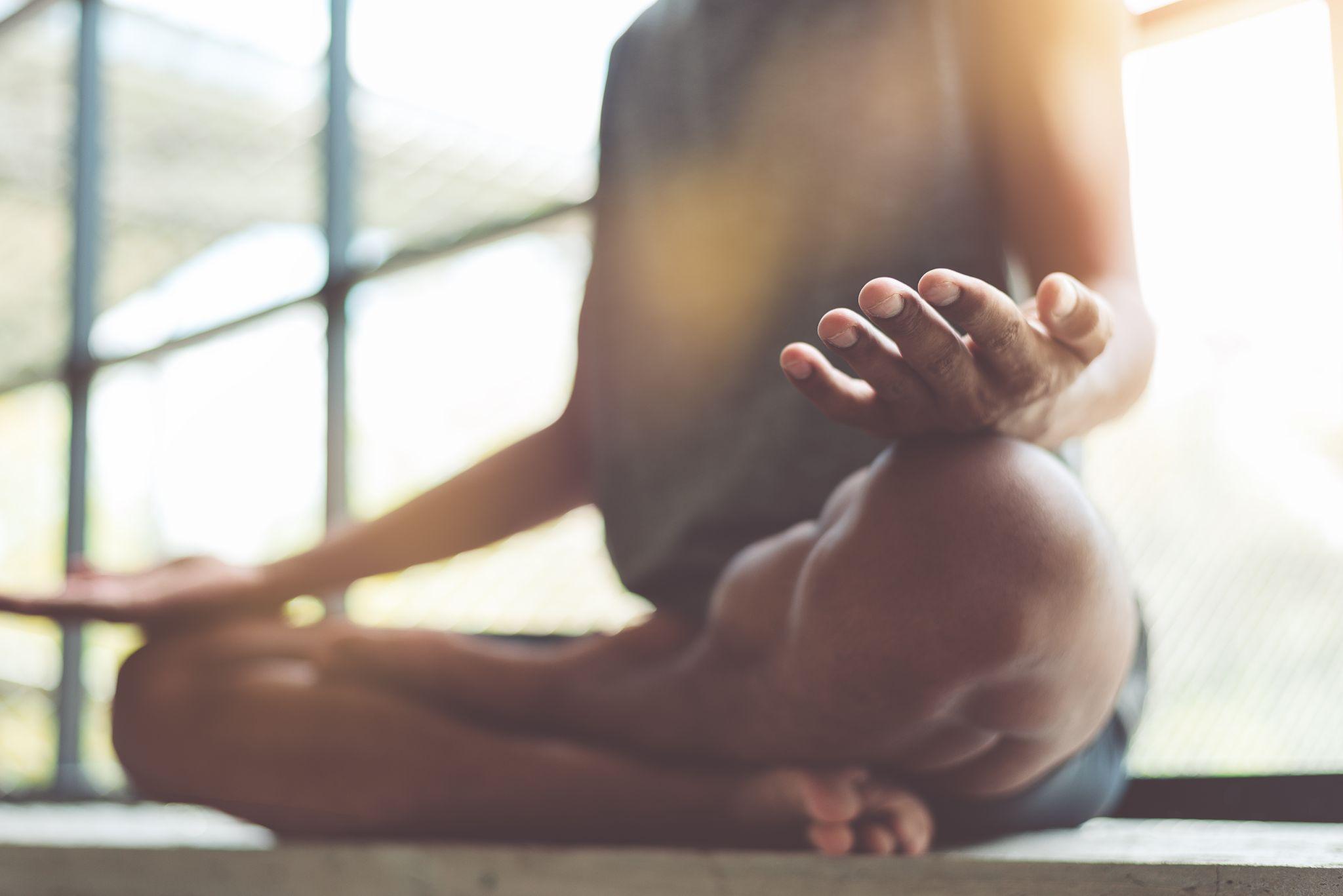
6 Types of Meditation for Addiction Recovery
Overcoming addiction is a path that requires compassion, understanding, and a multitude of supportive measures. One powerful and often overlooked tool against addiction is meditation.
This ancient practice, which spans thousands of years and crosses cultural boundaries, offers a hopeful approach toward healing. Lumina Recovery intends to share the various types of meditation that can be particularly beneficial for those going through addiction recovery.
The Different Forms of Meditation
At its core, practicing meditation focuses on mindfulness and concentration. It provides a momentary pause in the hustle of daily life, allowing individuals to turn their focus inward.
For those trying to beat addiction, meditation can serve as a grounding technique, helping to manage cravings, reduce stress, and enhance emotional well-being. By fostering a deep sense of calm and connectedness, meditation can be part of the foundation for recovery with many health benefits.
1. Mindfulness Meditation
Mindfulness meditation teaches the art of being present and fully paying attention to the present moment, without judgment or distraction. For individuals recovering from substance use disorders, this form of meditation is invaluable.
It cultivates an awareness of the present, allowing them to acknowledge cravings and emotional turmoil without automatically acting on them. Through mindfulness, individuals learn to observe their thoughts and feelings from a distance, recognizing that they are temporary and do not define one’s self.
2. Transcendental Meditation
Transcendental Meditation is a simple, effortless technique practiced for 15-20 minutes twice a day while sitting comfortably with the eyes closed. This is a form of mantra meditation that involves a personally assigned mantra that is repeated in your head to facilitate the transition to deep rest and relaxation.
This practice can help improve mental health by reducing stress, anxiety, and depression, which are common challenges faced by those in addiction recovery. By promoting a state of calm and inner peace, Transcendental Meditation supports emotional stability and resilience.
3. Loving-Kindness Meditation
Loving-kindness meditation, also known as metta meditation, involves the cultivation of a loving and kind perspective towards life, including the negative aspects such as addictive substances.
When practicing loving-kindness meditation, individuals focus on sending wishes of love, happiness, and well-being to themselves, loved ones, acquaintances, and even those with whom they may have conflicts.
This practice can be particularly transformative for someone in recovery, as it encourages forgiveness and self-compassion, helping to heal the wounds of substance abuse.
4. Yoga Nidra
Also known as yogic sleep, this technique induces a unique state of consciousness that hovers between wakefulness and sleep, induced by guided meditation. There is evidence to suggest that yoga nidra can be particularly effective in healing trauma, a common factor in many addiction cases.
During the practice, individuals lie down in a comfortable position and are guided through various stages of relaxation, awareness, and emotional healing. This process helps in releasing deeply held tensions and can significantly impact emotional and psychological recovery.
5. Body Scan Meditation
Body scan meditation involves a focused meditation where individuals sequentially tune into different parts of their body and the sensations they experience, moving from feet to head. This meditation encourages the awareness of one’s mind and body without judgment.
For those in recovery, it can be particularly enlightening to reconnect with the body in this way, as addiction often leads to a disconnection from the physical self. The body scan can help identify areas of tension and stress, promoting relaxation and a deeper understanding of the body’s needs.
6. Breath Awareness Meditation
This meditation is a practice that involves focusing solely on the act of breathing, noticing the breath as it enters and exits the body. This technique helps to anchor the mind in the present moment and promotes a sense of calm and focus.
For individuals dealing with addiction, breath awareness can be crucial for managing moments of craving or emotional upheaval. Focusing again on the breath offers a simple, effective method to regain control during challenging times.
Implementing Meditation Into Recovery

Incorporating meditation into the recovery journey from addiction is a process that encourages patience, persistence, and an open mind. Meditation, with its roots in ancient traditions, offers a modern-day sanctuary for individuals seeking solace and strength in their battle against addiction.
Here, we delve deeper into practical steps to seamlessly integrate meditation into the recovery process, ensuring it becomes a pillar of support and a source of inner peace.
Establish a routine. Setting a regular schedule for meditation helps in forming a habit. Choose a time of day when you are least likely to be interrupted and can dedicate your full attention to the practice. Morning sessions can set a positive tone for the day, while evening sessions may help in reflecting and unwinding.
Create a dedicated space. Designate a specific area in your home as your meditation space. This doesn’t need to be large. A quiet corner where you can sit comfortably without distractions will suffice. Personalize this space with items that promote peace and comfort, such as cushions, candles, or calming images.
Understand guided vs. self-led. For beginners, guided meditations can be incredibly helpful. They provide direction and focus, easing the mind into the practice. There are numerous resources available online, including apps and websites offering meditations tailored to addiction recovery. As you grow more comfortable, you may explore self-led sessions, using techniques learned from your guided experiences.
Focus on your breath. Breath awareness is a simple yet profound entry point into meditation. Concentrating on your breathing helps anchor the mind, making it easier to return to a state of calm when thoughts wander. This practice not only aids in meditation but also becomes valuable for managing cravings and emotional upheaval.
Embrace self-compassion. The path of recovery is often marked by challenges and setbacks. Approaching meditation with self-compassion means recognizing that perfection is not the goal—presence is. Each session is an opportunity to learn more about yourself, regardless of its perceived success or difficulty.
Practice patience. The benefits of meditation may not be immediate, but with consistent practice, its impact on mental clarity, emotional stability, and overall well-being can be transformative. Celebrate small victories, such as noticing when your mind wanders less or when you feel a bit more at peace after a session.
Incorporate mindfulness into daily life. Meditation is not confined to the moments spent in silence. Its principles can extend into daily activities. Practicing mindfulness during routine tasks such as eating, walking, or even during conversations can enhance awareness and appreciation for the present moment, reducing the urge to escape into addictive behaviors.
Find community support. Joining a meditation group or finding a meditation buddy can provide encouragement and accountability. Sharing experiences and challenges with others who understand the journey of recovery can strengthen your commitment to meditation and sobriety.
Listen to your needs. Your meditation practice should evolve with you. As you progress in your recovery, your needs may change. Be open to adjusting your practice, whether it means changing the length of your sessions, trying new techniques, or alternating between guided and self-led meditations.
Discover the Power of Meditation With Lumina Recovery
Meditation offers a path to tranquility and self-discovery for those navigating the complexities of addiction recovery. By exploring different types of meditation, individuals can find the practices that resonate most deeply with them, providing a source of strength and serenity.
Lumina Recovery provides specialized programs and dual diagnosis services that the power meditation can help support.
If you want to learn more about our services, don’t hesitate to reach out to us today.

How to Cultivate Gratitude in Addiction Recovery
The path on the road to recovery from drugs or alcohol can be filled with challenges, learning, and profound personal growth that tests one mentally, physically, and spiritually. Amidst the struggles, finding moments to express gratitude can be transformative.
Gratitude isn’t just about saying “thank you.” The attitude of gratitude is an acknowledgment of the goodness in our lives, a practice that can significantly impact mental health and resilience in recovery.
People in recovery and their loved ones should understand the importance of gratitude and learn ways to practice it throughout the recovery process.
Why is gratitude in recovery important?
Practicing gratitude in recovery from addiction is more than just focusing on positive emotions. It is a transformative force that has profound implications on an individual’s path to long-term healing and growth.
Psychological Shifts
Gratitude helps counter the brain’s natural tendency to focus on threats or negative thoughts. By recognizing and appreciating the positive aspects of life, individuals can shift their perspective to a grateful mindset.
Regular practice of gratitude has been linked to lower levels of envy, resentment, regret, and other negative emotions that can hinder recovery. It encourages a more joyful and content state of mind.
Physical Health
Gratitude has been shown to decrease stress levels, which is crucial for individuals in recovery, as stress is a common trigger for relapse. Lower stress levels also contribute to better physical health, including lower blood pressure and improved immune function.
People who express gratitude regularly are more likely to engage in healthy behaviors such as regular exercise, healthy eating, and adequate sleep, all of which support recovery.
Social Bonds
By expressing gratitude towards people in your life, individuals can deepen connections, build trust, and foster a supportive network. Gratitude can make others feel valued and appreciated, which strengthens relationships.
Gratitude not only improves existing relationships but also attracts new interactions and friendships. A grateful person often radiates positivity, which can draw others toward them.
Mental Health
The practice of gratitude can significantly reduce symptoms of depression and anxiety, which are common co-occurring conditions in individuals dealing with addiction. It promotes a more optimistic outlook on life, which can alleviate feelings of hopelessness and worry.
Gratitude builds psychological resilience, enabling individuals to bounce back from setbacks and challenges more effectively. This resilience is crucial in recovery, where setbacks can be part of the journey.
Sense of Purpose
Gratitude can help individuals see their recovery not just as a series of obstacles to overcome but as an opportunity for growth and self-discovery. This perspective can provide a sense of purpose and motivation.
Feeling grateful can inspire individuals to give back to others, whether through mentorship, volunteering, or simply offering support. This sense of contribution can reinforce one’s purpose and fulfillment in life.
Spiritual Well-Being
For many, gratitude is a spiritual practice that connects them to a sense of something greater than themselves. This connection can provide comfort, guidance, and a sense of peace during the recovery process.
Gratitude encourages living in the present moment and appreciating the here and now. This mindfulness can reduce desires for escapism and substance use as a coping mechanism.
7 Ways to Practice Gratitude in Addiction Recovery
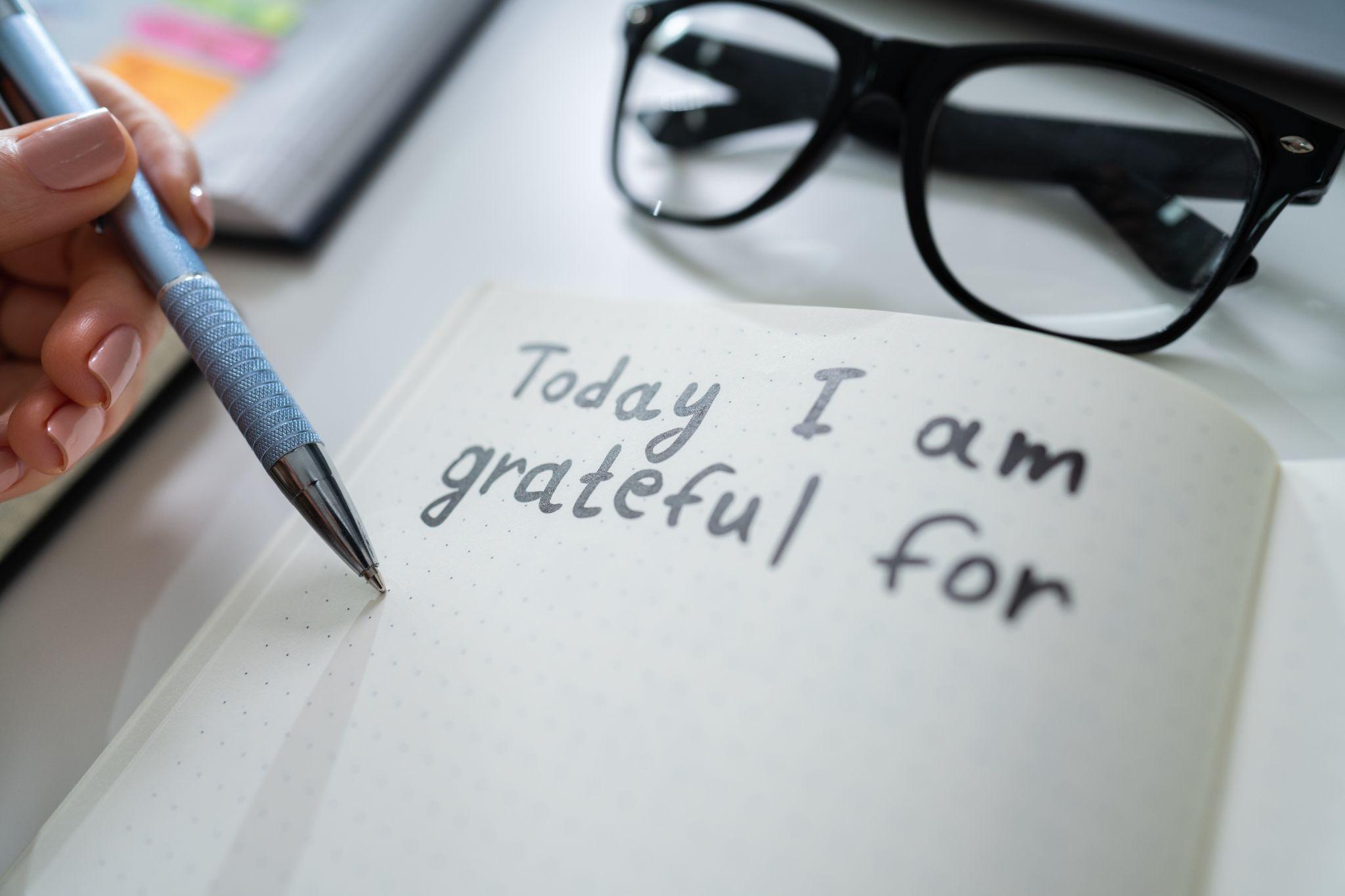
Expressing gratitude during the journey of addiction recovery can be both healing and transformative. Here are some strategies to cultivate gratitude:
- Keep a gratitude journal. Dedicate a few minutes each morning or evening to write down a gratitude list of three things you’re grateful for. These can be as simple as a warm meal, a conversation with a friend, or a peaceful moment. Occasionally, pick one entry and write a few sentences about why this particular thing makes you feel grateful. This practice can deepen your appreciation and understanding.
- Express thanks to those around you. Go beyond a simple “thank you” by expressing specifically what you appreciate about someone’s action or presence in your life. This could be through a heartfelt conversation, a written note, or a small gesture. Recognize the efforts of those who support you, whether they are family members, friends, therapists, or support group members. Let them know how their support has made a difference in your recovery journey.
- Volunteer your time. Look for volunteer activities that resonate with your interests or experiences. Helping others can reinforce your sense of purpose and gratitude. Consider organizing a group volunteering event with fellow recovery members or supporters. It’s a way to strengthen bonds and collectively give back.
- Practice mindfulness. Engage in mindfulness practices focused on gratitude. This can include meditation sessions where you visualize things you’re grateful for and allow yourself to feel appreciation. Take walks in nature and focus on the beauty around you. Acknowledge the sights, sounds, and smells that you’re thankful for.
- Reflect on your journey. Recognize and celebrate milestones in your recovery, no matter how small they may seem. Each step forward is an achievement worth gratitude. Keep a record of your recovery journey, noting the challenges you’ve overcome and the growth you’ve experienced. Reflecting on these can foster a profound sense of gratitude for your resilience and progress.
- Learn to accept and give compliments. When someone expresses thanks or compliments you, practice accepting it graciously. Recognize your worth and the impact you have on others. Similarly, offer genuine compliments and thanks to others. This not only spreads positivity but also reinforces your feelings of gratitude.
- Engage in creative expression. Use art, music, writing, or another form of creative expression to convey your gratitude. This can be a personal project or something you share with others. Put up a board in your home where you and others can pin notes, photos, or items that represent things you’re grateful for. This can serve as a daily reminder of the positive aspects of your life.
By incorporating these practices into your daily life, you can cultivate a deeper sense of gratitude that supports your recovery journey. Remember, gratitude is a practice that grows stronger with time, and it can significantly enhance the quality of your life and those around you.
Practice Gratitude With Lumina Recovery
Gratitude is more than a practice—it’s a way of living that can significantly enhance the recovery journey. By recognizing and appreciating the good in our lives, we can navigate the challenges of addiction recovery with a stronger, more hopeful spirit.
Our dual diagnosis programs and therapy services provide essential support to those looking for help during their addiction recovery. Let’s embrace gratitude as a key component of recovery, transforming our struggles into opportunities for growth and connection.
To learn more, talk to our team of professionals today.

How to Get Good Sleep in Addiction Recovery
On the road to recovering from addiction, every aspect of well-being matters. Most significantly, quality sleep is a pillar of good health, especially in addiction recovery.
Sleep can help heal and restore the body and mind, making it easier to cope with the challenges of recovery. Lumina Recovery wants to inspire you with knowledge on the importance of sleep during this critical time and offer practical tips to improve sleep quality.
The Importance of Sleep in Addiction Recovery
Sleep serves as a foundation for physical and mental health, especially during the challenging journey of addiction recovery. It’s a time when the body and mind can heal and rejuvenate, providing strength for the journey ahead.
Healing and Restoration
Addiction can take a significant toll on the body. Sleep facilitates physical healing by allowing the body and central nervous system to repair itself. During deep sleep, tissue growth and repair occur, vital organs rest, and energy is restored.
Substance abuse can also affect brain function and structure. Sleep helps to restore and rebalance brain chemicals, supports the formation of new neural connections, and enhances cognitive functions such as memory, problem-solving, and decision-making.
Emotional and Psychological Well-Being
Sleep plays a critical role in managing emotions. Disrupted sleep can exacerbate feelings of anger, sadness, or anxiety. Adequate rest helps regulate mood, increasing resilience and reducing the risk of relapse.
Recovery can be a stressful time. Sleep reduces cortisol levels (the stress hormone) and supports the balance of other neurotransmitters, promoting a sense of calm and well-being.
Concentration and Focus
Sleep deprivation can lead to decreased attention, impaired memory, daytime fatigue, and reduced executive function. Getting enough sleep improves concentration, focus, and the ability to learn, which are essential for those in recovery working to rebuild their lives.
Healthy Choices and Behaviors
Well-rested individuals are better equipped to make healthy choices, resist cravings, and avoid triggers. Sleep enhances executive function, which is responsible for planning, impulse control, and adhering to recovery plans.
Sleep strengthens the immune system, making the body more capable of fighting infections and diseases. This is particularly important for individuals in recovery, as their bodies may be more vulnerable after extended periods of substance abuse.
Social Connections
Adequate sleep can improve social skills and emotional intelligence, making it easier to reconnect with loved ones and build new, supportive relationships that are crucial for long-term recovery.
In essence, sleep is not just a passive state but an active process that supports every facet of recovery. It’s a vital ingredient in the recipe for resilience, healing, and growth. Prioritizing sleep is prioritizing recovery itself.
8 Tips for Getting Good Sleep in Addiction Recovery

1. Establish a Regular Sleep Schedule
Be consistent. Regulating your internal clock by going to bed and waking up at the same time every day, including weekends, is important for creating a sleep schedule. This consistency makes it easier to fall asleep and wake up naturally, improving sleep quality over time.
Adjust gradually. If your current sleep schedule is far off your target, adjust it gradually, in 15-minute increments, to ease the transition toward healthy sleep habits.
2. Create a Restful Environment
Optimize your bedroom. Ensure your bedroom is a sanctuary for sleep. Keep it quiet, dark, and at a comfortable temperature. For good sleep hygiene, consider using blackout curtains, eye masks, earplugs, or white noise machines to block out light and noise.
Have comfortable bedding. Invest in a high-quality mattress and pillows that support your body and sleeping style. The right bedding can make a significant difference in your comfort and the quality of your sleep.
Limit bedroom activities. Use your bedroom only for sleep and intimacy. Avoid working, eating, or watching TV in bed to strengthen the mental association between your bedroom and sleep.
3. Mind Your Diet and Exercise
Watch what you eat and drink. Avoid caffeine and nicotine close to bedtime as they can keep you awake. Also, avoid heavy or large meals within a couple of hours of bedtime. If you’re hungry at night, eat a light, healthy snack.
Do regular physical activity. Engage in regular, moderate exercise, but not too close to bedtime. Exercise can help deepen your sleep. However, exercising too close to bedtime may make it harder to fall asleep.
4. Establish a Bedtime Routine
Start winding down. Spend the last hour before bed doing calming activities to help your body recognize it’s time to wind down. This could include reading, taking a warm bath, gentle stretching, or meditation.
Listen to soothing music or sounds. Integrating calming music or nature sounds into your bedtime routine can help relax your mind and ease you into sleep. Choose melodies or sounds that are slow and serene, such as gentle piano music, ocean waves, or soft rain, to create a peaceful atmosphere conducive to sleep.
5. Limit Screen Time
Avoid social media. Scrolling through social media can be stimulating rather than relaxing, keeping your mind engaged and making it harder to fall asleep. Set a specific time to disconnect from social media in the evening to help your mind unwind and prepare for a restful night’s sleep.
Put your devices away. Electronic devices like smartphones, tablets, and computers emit blue light, which can interfere with the body’s natural sleep-wake cycle. Create a habit of putting your phone away at least an hour before bedtime to help your brain prepare for sleep.
6. Seek Professional Help if Needed
Consult a healthcare provider. If you’re experiencing persistent sleep disturbances, it may be helpful to consult with a healthcare provider or a sleep specialist. They can assess for sleep disorders such as insomnia or sleep apnea, which may require specific treatments.
Explore cognitive behavioral therapy for insomnia (CBT-I). CBT-I is a highly effective treatment for insomnia. It involves changing sleep habits and scheduling, as well as misconceptions about sleep and insomnia, without the need for medication.
7. Practice Relaxation Techniques
Manage stress. Stress and anxiety can significantly impact sleep quality. You can try meditation, deep breathing, or light yoga to help reduce stress levels and prepare your mind and body for sleep.
Try mindfulness or guided imagery. Mindfulness meditation and guided imagery can be practiced before bedtime to help calm an active mind and ease into sleep.
8. Stay Positive
Keep a gratitude journal. Writing down things you are grateful for can shift your focus away from stress and anxiety towards positive thoughts, making it easier to relax and fall asleep.
Practice positive affirmations. Positive affirmations before bed can help create a more optimistic mindset, reduce stress, and improve sleep quality.
Improve Sleep During Addiction Recovery With Lumina Recovery
Good sleep is vital in addiction recovery, offering numerous benefits to help heal the body and mind. By establishing a healthy sleep routine and creating an environment conducive to rest, individuals in recovery can significantly improve their sleep quality.
Support from healthcare professionals, alongside these practical tips, can make a significant difference in your recovery journey. Lumina Recovery offers therapy services that can help promote sleep and healing.
Contact our team today to learn more about how we can help you or your loved one.
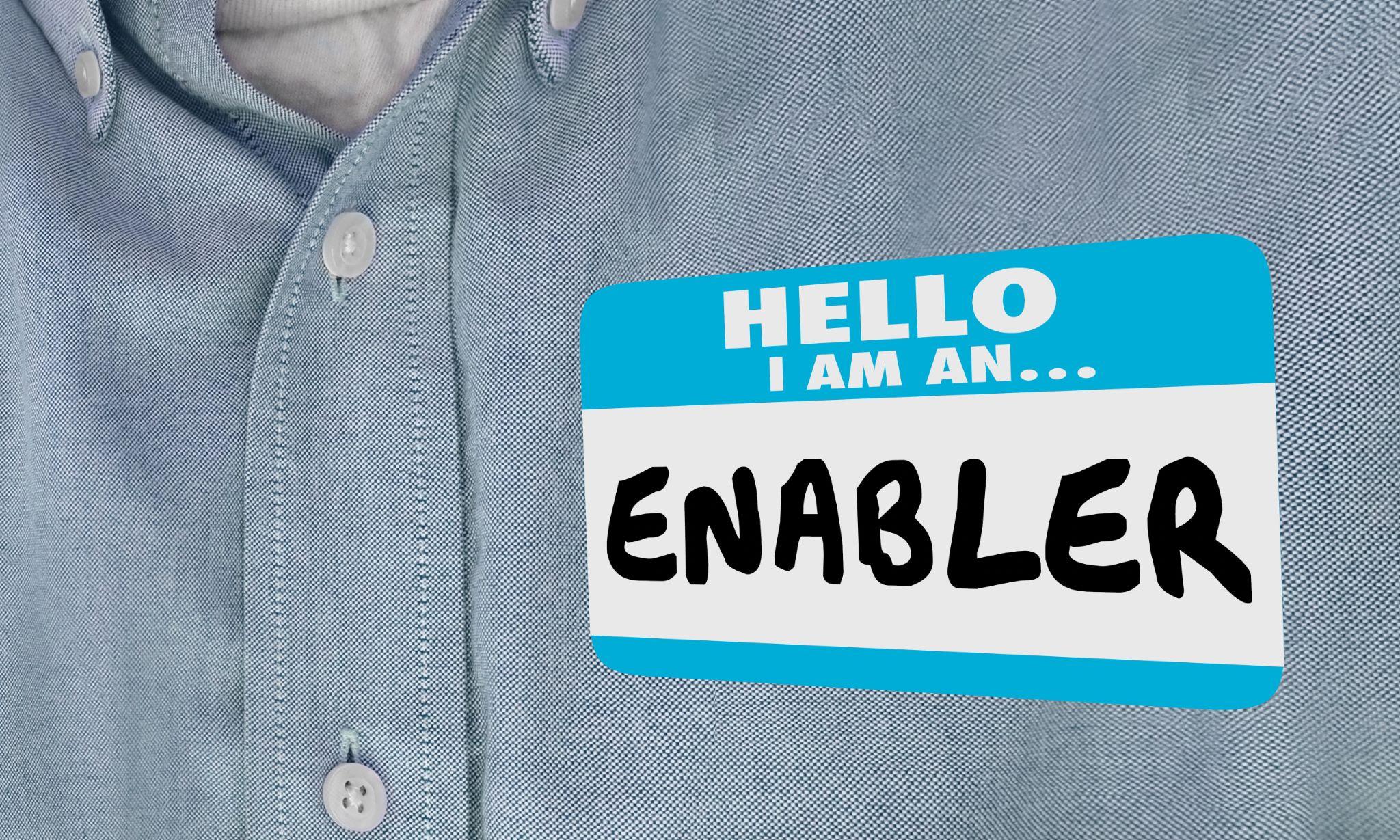
Are You an Enabler?
In the journey of dealing with addiction to drugs or alcohol, one of the toughest realizations may be recognizing one’s own role in the cycle of dependency. Whether you are struggling with an addiction or watching a loved one battle with it, understanding the dynamics of enabling behavior is crucial.
Enabling can unintentionally carry on the cycle of addiction or substance abuse, making it harder for the person suffering to seek the help they need. Lumina Recovery intends to provide important knowledge on what it means to be an enabler, how to identify enabling behaviors, and steps to transform these actions into supportive, healing gestures.
If you’re questioning whether your actions might be enabling a loved one’s addiction, this guide is for you.
Recognizing Enabling Behavior
Recognizing enabling behavior is the first step toward making a positive change in the cycle of addiction. Enabling behaviors may start from a place of love or desire to protect, but they can end up reinforcing the addiction. Let’s delve deeper into these signs:
Denying the Problem
Pretending the addiction is not as severe as it is can be tempting. This might look like ignoring the issue, making light of the consequences, or believing that the situation will resolve itself without intervention.
Covering Up
This involves hiding the truth about your addicted loved one’s behavior from others. For example, you might find yourself lying or making excuses for your loved one to friends, family, or employers about why they are missing work or social events.
Providing Financial Support
While it might seem helpful to lend money to someone struggling with addiction, this can often lead to funding their substance use. Financial support can also come in the form of paying bills, debts, or legal fees that the addicted person is responsible for.
Avoiding Conflict
It’s natural to want to avoid arguments, but consistently steering clear of confronting the addicted person about their behavior can enable the addiction to continue. This avoidance can also mean making excuses for their actions or behaviors.
Taking Over Responsibilities
When you start handling tasks that the addicted person should be managing, like household chores, parenting, or work duties, you allow the addiction to consume their life without facing the natural consequences of their actions.
By recognizing these behaviors in ourselves, we can begin to understand how they contribute to the cycle of addiction and take steps to modify our actions.
Comprehending the Impact
The impact of enabling behavior extends beyond the addicted individual—it affects the enabler and the broader relationship dynamics between family members or close relationships. These effects include:
- Delayed Realization: Enabling behaviors can prevent the addicted person from seeing the full extent of their problem. Without facing the natural consequences of their actions, they may not recognize the need for change.
- Emotional and Physical Toll: For enablers, constantly covering up, providing financial support, and avoiding conflicts can lead to stress, anxiety, and even physical health issues. The emotional burden of managing another person’s addiction can be overwhelming.
- Blurred Boundaries: Enabling often involves crossing boundaries that would typically be in place to maintain a healthy relationship. This can lead to a loss of respect, trust, and the enabler’s own sense of self.
- Hindered Motivation to Change: Protecting an addicted loved one from the consequences of their actions removes a significant motivator for seeking help and making a change. The lack of accountability can stall the recovery process.
Understanding these impacts is crucial for recognizing the need to shift from enabling to supporting. Support involves encouraging professional help, setting and maintaining healthy boundaries, and taking care of your well-being. By changing our approach, we can offer help that empowers our loved ones to take the necessary steps towards recovery.
10 Steps to Stop Enabling

Changing enabling behaviors requires awareness, intention, and sometimes, a significant shift in dynamics within the relationship. Here are steps to help you move toward positive change:
- Acknowledge the behavior. Recognizing that your actions, no matter how well-intentioned, may be enabling addiction is a pivotal first step. Reflect on your behaviors and consider how they may be preventing your loved one from facing the necessary consequences of their actions.
- Educate yourself about addiction. Understanding addiction as a complex disease will help you approach your loved one with empathy and informed support. Learn about the psychological and physical aspects of addiction, treatment options, and the recovery process. This knowledge can change how you respond to the addicted individual’s behaviors and needs.
- Set clear and firm boundaries. Establishing boundaries is crucial for your well-being and for encouraging your loved one to take responsibility for their actions. Setting boundaries might include not lending money, refusing to cover up their behaviors, or setting limits on how much you will involve yourself in their crises. Communicate these boundaries clearly and consistently enforce them.
- Encourage responsibility. Instead of taking over their responsibilities, encourage your loved one to take charge of their life. This could mean letting them face the natural consequences of their actions, such as dealing with legal issues or job loss. Support them in finding solutions, but resist the urge to fix problems for them.
- Seek support for yourself. Dealing with a loved one’s addiction can be isolating and overwhelming. Seek support from groups like Al-Anon, where you can share experiences and gain insights from others in similar situations. Consulting with a therapist can also provide you with strategies to cope and maintain your mental health.
- Promote treatment and recovery. While you cannot force someone to seek treatment, you can encourage and support their journey to recovery. Research treatment options, offer to help with logistics like making phone calls or arranging transportation, and express your belief in their ability to recover. Celebrate small victories and remain supportive, even through setbacks.
- Practice self-care. Taking care of yourself is not selfish, it’s necessary. Engage in activities that nourish your body, mind, and spirit. Maintaining your health ensures you have the strength to offer support and sets a positive example for your loved one.
- Learn effective communication skills. Communication is key in supporting someone with an addiction. Learn to express your feelings and concerns without judgment or blame. Use “I” statements to speak about your experiences and feelings, and listen actively to your loved one’s perspective.
- Adjust expectations. Recovery is a journey with ups and downs. Adjusting your expectations can help you remain supportive without being disillusioned by setbacks. Understand that progress may be slow and that relapse can be part of the recovery process.
- Stay informed and flexible. As you and your loved one navigate the path of recovery, staying informed about addiction and being flexible in your approach can make a significant difference. Be open to changing strategies if something isn’t working and celebrate every step forward, no matter how small.
Empower Healing With Lumina Recovery
Identifying enabling behaviors in ourselves can be challenging, but it’s a crucial step towards healing, not just for our loved ones battling addiction but for our well-being. By recognizing and changing these behaviors, we can truly support our loved ones in their recovery journey.
Remember, it’s about providing the kind of help that leads to lasting change. Lumina Recovery provides family therapy and outpatient services to help those struggling with addiction and their loved ones.
To learn more, reach out to our team today.
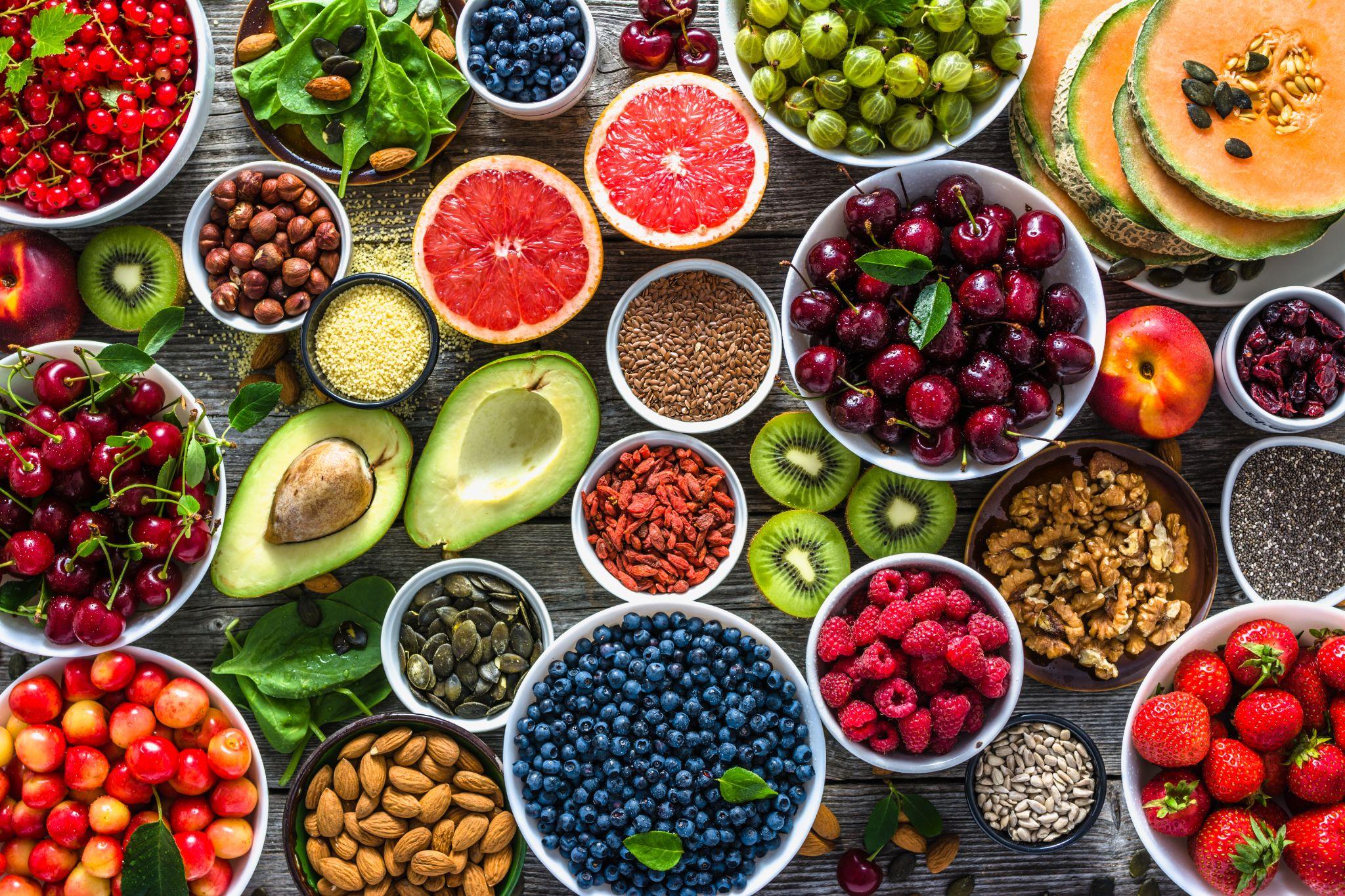
The Importance of Nutrition in Addiction Recovery
Recovery from drug and alcohol addiction is a journey that encompasses much more than simply abstaining from substances. It’s a comprehensive process that involves healing the body, mind, and spirit.
One of the key aspects of this healing process that often gets overlooked is good nutrition. Proper nutrition plays a crucial role in recovery from addiction. It helps repair the body, boosts mental health, and provides the energy needed for the journey towards sobriety.
Below, we will delve into why nutrition is so important in addiction recovery and how it can aid individuals or their loved ones on the path to a healthier life.
The Role of Nutrition in Healing the Body
Substance use disorders can severely impact the body, leading to nutritional deficiencies, weakened immune response, and organ damage. Nutrition can help serve as a foundation for reversing these detrimental effects.
Repairing organ damage. Substance abuse can damage vital organs, including the liver and brain. Nutrients play a pivotal role in organ recovery.
For instance, omega-3 fatty acids, abundant in fish, chia seeds, and walnuts, are essential for brain cell repair, especially in individuals recovering from alcohol addiction. Similarly, antioxidants and amino acids in fruits and vegetables can help liver cells regenerate, helping mitigate the effects of alcohol or drug-induced liver damage.
Boosting the immune system. A compromised immune system is a common consequence of substance abuse. A diet rich in vitamins and minerals is crucial for immunological repair.
Foods high in vitamin C (citrus fruits, bell peppers, and broccoli), vitamin E (nuts, seeds, and spinach), and zinc (meat, shellfish, and legumes) can significantly enhance immune function, helping the body defend against infections more effectively. These vitamins can also help reduce cravings and promote healthy skin and hair growth.
Improving gut health. Addiction can disrupt the gut microbiome, leading to digestive issues and impaired nutrient absorption. A balanced diet with healthy foods rich in prebiotics and probiotics, such as yogurt, kefir, bananas, and garlic, can help restore gut health. This can improve digestion and the absorption of nutrients, crucial for overall health and recovery.
Enhancing Mental Health Through Nutrition
The relationship between nutrition and mental health is profound. Substance abuse and poor nutrition can exacerbate mental health disorders. Conversely, a balanced diet can help improve mental well-being.
Foods rich in tryptophan can have a positive effect on mood. Tryptophan, found in turkey, eggs, and dairy, is a precursor to serotonin, a neurotransmitter that promotes feelings of well-being and happiness. Incorporating these nutrients can help alleviate symptoms of depression and improve mood stability.
Certain nutrients have also been shown to help reduce anxiety. Magnesium (found in leafy greens, nuts, and whole grains) and omega-3 fatty acids can help lower anxiety levels. Additionally, complex carbohydrates like oats and brown rice can increase the production of serotonin in the brain, further helping to reduce anxiety and stress.
Lastly, substance abuse can impair cognitive function, but nutrition can help counteract these effects. Foods rich in antioxidants, such as berries and nuts, help protect the brain from oxidative stress, enhancing cognitive functions. B vitamins, particularly B12 (found in meat, fish, and dairy), are vital for maintaining healthy nerve cell membranes and can help improve memory and thinking.
Energy and Recovery
The path to recovery demands significant physical and mental energy. From therapy sessions and support meetings to the daily activities of rebuilding a life free from substances, the energy required is immense. Nutrition is the key to sustaining this energy level.
To maintain the energy necessary for recovery, it’s important to focus on eating balanced meals that provide steady, long-lasting energy. Complex carbohydrates, found in foods like whole grains, legumes, and vegetables, are essential. Unlike simple sugars, which can lead to energy spikes and crashes, complex carbs provide a slow and steady release of energy, keeping you fueled throughout the day.
Regular physical activity is often a critical component of the recovery process, improving both physical health and mental well-being. Protein plays a vital role in supporting this activity. Adequate protein intake ensures the body can sustain physical exercise, which is vital for enhancing mood and reducing stress. Lean meats, fish, legumes, and dairy products are excellent protein sources.
Recovery also requires mental as well as physical energy. Foods rich in antioxidants and vitamins can help improve cognitive function and mental clarity. Incorporating a variety of fruits, vegetables, nuts, and seeds into your diet can boost focus and concentration, aiding in therapy sessions and personal reflection.
Practical Tips for Incorporating Nutrition Into Recovery

Adopting a nutritious diet during recovery treatment programs might seem daunting, but with the right approach, it’s entirely achievable. Here are some practical tips to help integrate nutrition into the recovery journey:
- Start small and simple. Overhauling your diet overnight can be overwhelming. Begin with small, manageable changes that you can stick with over time. This could be as simple as adding an extra serving of vegetables to your meals or swapping out sugary snacks for healthier options.
- Stay hydrated. Proper hydration is crucial for overall health and can significantly impact energy levels and cognitive function. Drinking enough water throughout the day can also help manage hunger and improve digestion.
- Start meal planning. Planning meals in advance can help ensure you’re eating a balanced diet and avoid the temptation of less healthy options. Preparing meals ahead of time can also save time and reduce stress, making it easier to stick to healthy eating habits.
- Seek support from professionals. Nutrition can be complex, especially when recovering from addiction. Consulting with a registered dietitian or nutritionist who understands the unique needs of those in recovery can provide personalized guidance and support.
- Try mindful eating. Focus on what you eat and how you feel after. Mindful eating can help you recognize which foods boost your energy and mood and which ones don’t, allowing you to make better choices for your body and mind.
- Incorporate variety. Eating a wide range of foods ensures you get all the necessary nutrients your body needs to heal and thrive. Experiment with new foods and recipes to keep your diet interesting and enjoyable.
Learn About Nutrition and Addiction With Lumina Recovery
Embracing nutrition as part of the recovery process is not just about eating healthily—it’s about rebuilding and nourishing the body and mind from the inside out. It’s an act of self-care that reinforces the commitment to a new, healthier lifestyle free from addiction.
A balanced and nutritious diet compliments the therapy options and dual diagnosis programs Lumina Recovery offers as part of the recovery journey.
If you want to learn more for yourself or a loved one, don’t hesitate to contact us today.
Additional Resources
Once you have completed your rehabilitation program at one of our drug and alcohol treatment centers, you should try to surround yourself with people who can encourage you to stay sober. Many people find that support groups are the best source of encouragement. You can find hundreds of support groups and meetings in your community. Our drug addiction treatment centers stress the importance of personal chemical dependency resources, especially when you are new to sobriety. Below are various addiction and mental health resources for people in recovery who want additional support.
Christian Addiction Recovery Resources
Our substance abuse services aren’t limited to specific programs, but rather we believe in the importance of incorporating faith-based programs to promote spiritual healing, like our Faith in Recovery program.
With that said, below are some faith-based addiction recovery resources that could help you in your spiritual healing from addiction:
- Battlefield of the Mind by Joyce Meyer
- Boundaries by Dr. Henry Cloud & Dr. John Townsend
- Christian Families in Recovery: A Guide for Addiction, Recovery, and Intervention Using God’s Tools of Redemption by Robert and Stephanie Tucker
- Club New Life Christian Ministry for Addiction and Recovery
- Lost & Found: Recovery in Christ by Bruce Stanley
- Overcoming Emotional Obstacles through Faith: Navigating the Mind Field by Anthony Acampora, Director of Banyan’s Faith in Recovery Program
- The Case for Christ by Lee Strobel
Mental Health Resources for Recovery
Lumina Recovery consist of both mental health and substance abuse treatment facilities, meaning we offer mental health resources as well as chemical dependency resources. What’s more, addiction often co-occurs with mental illness, making these resources ever more important.
Below are some resources for mental health recovery that can help you or your loved one:
- This Emotional Life video series
- No Kidding, Me 2!! with Joe Pantoliano
- Dare: The New Way to End Anxiety and Stop Panic Attacks by Barry McDonagh
- Pleasure Unwoven: An Explanation of the Brain Disease of Addiction by Kevin McCauley
- Declutter Your Mind: How to Stop Worrying, Relieve Anxiety, and Eliminate Negative Thinking by S.J. Scott and Barrie Davenport
Call Us Today – (877) 716-7515
